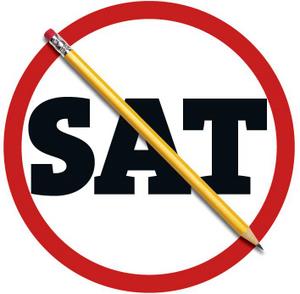
If you were sixteen or seventeen years old, how would you answer this question? “Does the present system of education encourage us to admit our lack of knowledge, or is there too much pressure to demonstrate the acquisition of knowledge?” While formulating a viewpoint and proving this idea with cohesion, clarity, structure, and organization, your internal clock informs your brain that all students are required to answer the essay portion of the SAT exam in twenty five minutes, the length of an episode of your favorite TV shows — Family Guy and South Park. In reality, students don’t actually know if the current system of education encourages questions or puts pressure on them to demonstrate acquisition of knowledge. What they do know is that they have to answer the question, immediately, or their writing section is tanked. Regardless, in the small twenty five minute time-frame of answering the elusive question, they certainly feel the second choice given in the prompt.
The new SAT, which takes effect in 2016, allows for an option, though. If you can’t write a solid essay in the time of one episode of your favorite comedy television series, this inability won’t hurt your score. Multiple changes in the SAT such as this one eliminate the needlessly difficult and annoying aspects of the test that hurt the scores of perfectly adequate readers, writers, and problem solvers. Other changes of the test include the following: no penalty for wrong answers, relevant words in the context, stress on the importance of command of evidence, and real-world context in questions. Overall, the redesigned SAT has net positivity and will more accurately reflect the changing landscape of education.
Currently, the point system for the SAT exam is slightly confusing. A student receives one point for every question answered correctly, is deducted one-fourth a point for every wrong answer, and receives zero points for a question left blank. The thinking behind leaving a question blank is that if a student has no idea how to answer a question, he or she will not be deducted points. Assuming that a choice is a good decision is incorrect because leaving questions blank is almost as harmful as answering a question incorrectly, for a student does not accumulate points to the overall score of that section.
Hence, the College Board eliminated point deductions. For the redesigned test, a student will receive one point for every question he or she answers correctly and zero points for every question answered incorrectly. The idea is to encourage students to answer normal questions and make educated, informed choices on difficult questions. The change is long overdue. Certain forms of test-taking strategies are critical and important, such as time-management and outlining parts of the test. But having to resort to multiple, silly forms of test-taking strategies, which discourage students from even answering a question, reflects a poorly designed test structure. In 2016, at least, a student can answer every question to the best of his or her abilities.
After news of the future changes, people asked another common question. Do these changes lower the rigor of the test? The redesigned SAT test will have somewhat of a different structure, but there isn’t any proof that the changes compromise the difficulty of the questions. Certain questions will have relevant, real world context, which the College Board now stresses, but how does that lower rigor, exactly? What’s wrong with teaching a student the value of what they are learning? The context behind a subject isn’t harmful; it’s helpful. Also, why would the College Board want to lower the rigor of the test? So student’s scores would go up, making everyone feel better? Do people really think the College Board feels concern over student morale?
Education isn’t devolving. Instead, it is becomingmore challenging, evolving through initiatives such as the Common Core. The National Common Core Standards allows states to compare standardized test scores more accurately, creating a homogenous education experience for all US students no matter where they live. This idea allows students across the nation to have the same quality education is a must in our 21st century world. So while the standards of the Common Core test PARCC are considered a little lower than the current MCAS, overall the Common Core increases rigor in the classroom setting in most states across the nation. The standards are also internationally benchmarked, which means they meet the standards of nations ahead of the US in education. With these higher standards, schools in America can close this gap with other nations in reading, math and science.
David Coleman — the head of the College Board and a cheif architect of the Common Core — is trying to align the SAT with these new standards set by the National education standards. This means that the changes do not only increase rigor, but give a fair evaluation of what is federally mandated to be learned in school.
But really, so what? Increased rigor in the classroom setting is necessary. Professors in higher education have complained for far too long that too many students need remediation at the beginning of college, and the Common Core strives to better prepare students for post-secondary education. Also, despite what the critics say, it is not a dose of Kool-Aid the federal government is forcing down our throats. The federal government does not control education through Common Core. According to a featured partner of the Daily Caller, “States choose how the standards should best be put into practice in their school districts. The Common Core State Standards do not dictate curricula, how teachers teach or how students learn. Those are issues for local control and decision.” Thus, while a set of national standards is in place, parents, teachers, education experts, policymakers, and business people on the local level choose how these standards should apply to the classroom. Again, the federal government isn’t concerned with controlling the education system. Everyone knows education works best when individuals at the state and local level, who know their students best, hold this power.
The new SAT changes reflect the continued evolution of education. We can resist these changes, protest them, or we can embrace them. They encourage students to think critically and answer questions — all of them. Yet, students also aren’t burdened by some of the inferior designs of a standardized test. The new SAT test won’t be perfect. Standardized tests alone do not indicate the degree of success a student will have in college. But it will give a fairer, equitable, and more reasonable assessment of education for the future.









